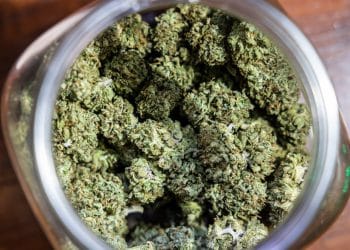There are many roads waiting to be drawn on the Cannabis sativa map. We have a decent understanding of cannabinoids, especially cannabidiol (CBD) and delta-9-tetrahydrocannabinol (THC), but terpenes are a whole new world we’re determined to explore.
Terpenes are secondary chemical compounds found in a variety of plants, fruits, and flowers – including cannabis. They determine the characteristic smells and flavors of different cannabis cultivars. Like cannabinoids, terpenes can affect our mental and physical states but in a much more nuanced way.
As Chief Scientific & Product Officer of PLUS Products, a cannabis gummies brand, I lead the development of various product formulations for different effects – whether it’s to encourage a restful sleep or to enhance creativity. We’ve always been methodological in utilizing cannabinoids to design experiences; terpenes are now another natural ingredient we’re using to derive specific mental and physical benefits.
These tiny powerhouses are a trending topic across the industry and we’re beginning to see them deliberately added into new cannabis products. Consumers are increasingly interested in holistic healing and wellness products, whether it be plant-based supplements or functional drinks. Cannabis is a part of that wellness category and companies are answering the consumer demand with the addition of functional ingredients like cannabinoids, botanicals, and, yes, terpenes.
The exact effects that different terpenes elicit are still being researched, but we have early scientific and anecdotal evidence that points to various benefits. There are more than 150 types of terpenes in the cannabis plant, in addition to the multitudes present in other plants.
Terpenes like myrcene, beta-caryophyllene, and alpha-humulene are present in most cannabis plants [1] with myrcene often dominating the terpene profile of many cannabis plants. [2] This monoterpene is known for increasing cell permeability and has been speculated to enable quicker cannabinoid absorption, although the scientific literature on this latter point seems to be lacking. [3] Limonene, which is also found in citrus, has been shown to have anti-inflammatory properties and to help reduce anxiety. [4] Found in cannabis as well as basil, oregano, and black pepper, beta-caryophyllene may have antioxidant, anti-inflammatory, and analgesic benefits. [5] Pinene and linalool both offer a host of therapeutic effects that have encouraged the scientific community to explore their potential to relieve inflammation, depression, and insomnia. [6] Preliminary research is even exploring these terpenes’ ability to serve as protective agents against brain injury associated with stroke and seizures.
There are a handful of other terpenes waiting to be discovered and researched so we can uncover their full potential. While they each present their own unique experiences, we’ve found the most impact is derived when they’re combined in varying ratios.
All About Ratios
Terpenes work best in combination rather than alone. At PLUS, we’ve been using “cocktails” that usually incorporate around ten terpenes, and we work with a formulator to construct specific effects.
If you look at these cocktails, though, you’ll see that the components are often similar across samples. You see, it’s not so much about milligrams or type; it’s a question of relative ratio and adjacent terpenes that come into the mix.
For example, if we’re looking to make a relaxing and pain-relieving cannabis-infused product, we may focus on pinene, linalool, limonene, and beta-caryophyllene. But it’s not that simple. We would need to examine which terpenes have the largest effect in which quantities when combined with others. And since products must also be palatable to consumers, we need to take into account how each terpene affects the overall flavor and determine what other flavor additions we need to create a product consumers will actually enjoy.
You will see dominant terpenes like limonene in many different formulations – what’s key is how much limonene is present compared to other terpenes. The combinations and ratios of terpenes, as well as cannabinoids, create the biological effect you’re seeking.
Terpenes for the Future of Natural Medicine
Can I tell you for a fact that X terpene will drive Y effect? It’s difficult to say because our understanding of terpenes is an evolving story. We’re leaning on a combination of basic and translational sciences to supplement anecdotal evidence, but we haven’t been able to tap into solid clinical science yet.
We are exploring the many different types of terpenes to purposefully curate cocktails that bring about certain benefits and effects. There are several ailments, from anxiety and sleep to inflammation, that terpenes may help relieve. Terpenes are a critical component in the chemical milieu that we are trying to extract from cannabis, and we believe that, in their combination, we are able to harness their power and create cannabis products that can help sidestep more conventional pharmaceutical demands.
The science behind terpenes is yet to be fully baked and we need to push harder not just on the mouse work but on human clinical work. There’s so much information and health potential just waiting to be discovered.
References
[1] Booth JK, Bohlmann J. Terpenes in Cannabis sativa – From plant genome to humans. Plant Sci. 2019;284:67-72. [journal impact factor = 4.729; times cited = 88]
[2] Giese MW, Lewis MA, Giese L, Smith KM. Development and validation of a reliable and robust method for the analysis of cannabinoids and terpenes in Cannabis. J AOAC Int. 2015;98(6):1503-1522. [journal impact factor = 1.913; times cited = 84]
[3] Surendran S, Qassadi F, Surendran G, Lilley D, Heinrich M. Myrcene-what are the potential health benefits of this flavouring and aroma agent?. Front Nutr. 2021;8:699666. [journal impact factor = 6.576; times cited = 0]
[4] Liktor-Busa E, Keresztes A, LaVigne J, Streicher JM, Largent-Milnes TM. Analgesic potential of terpenes derived from Cannabis sativa. Pharmacol Rev. 2021;73(4):98-126. [journal impact factor = 25.47; times cited = 0]
[5] Gertsch J, et al. Beta-caryophyllene is a dietary cannabinoid. Proceedings of the National Academy of Sciences of the United States of America. 2008;105(26): 9099-9104. [journal impact factor = 11.2; times cited = 581]
[6] Weston-Green K, Clunas H, Jimenez Naranjo C. A review of the potential use of pinene and linalool as terpene-based medicines for brain health: Discovering novel therapeutics in the flavours and fragrances of cannabis. Front Psychiatry. 2021;12:583211. [journal impact factor = 3.532; times cited = 0]












